Amazon.com Marketing Brand Management Executive Summary
VerifiedAdded on 2023/01/10
|14
|3560
|32
Report
AI Summary
This report provides an executive summary of Amazon's brand management, analyzing its brand portfolio, brand elements, and marketing mix. It delves into brand awareness, brand image, and the sources of Amazon's brand equity. The analysis includes an evaluation of Amazon's target market and identifies potential threats to its brand equity. Furthermore, the report offers recommendations for Amazon, focusing on its brand attributes and strategies to maintain its market position. The report underscores the importance of brand elements like the brand name, logo, and packaging, and how these contribute to Amazon's memorability and likability. It also examines the impact of pricing, place, and promotion strategies on brand equity, providing a comprehensive overview of Amazon's brand management approach.

Amazon.com
Marketing
Brand Management
Marketing
Brand Management
Paraphrase This Document
Need a fresh take? Get an instant paraphrase of this document with our AI Paraphraser
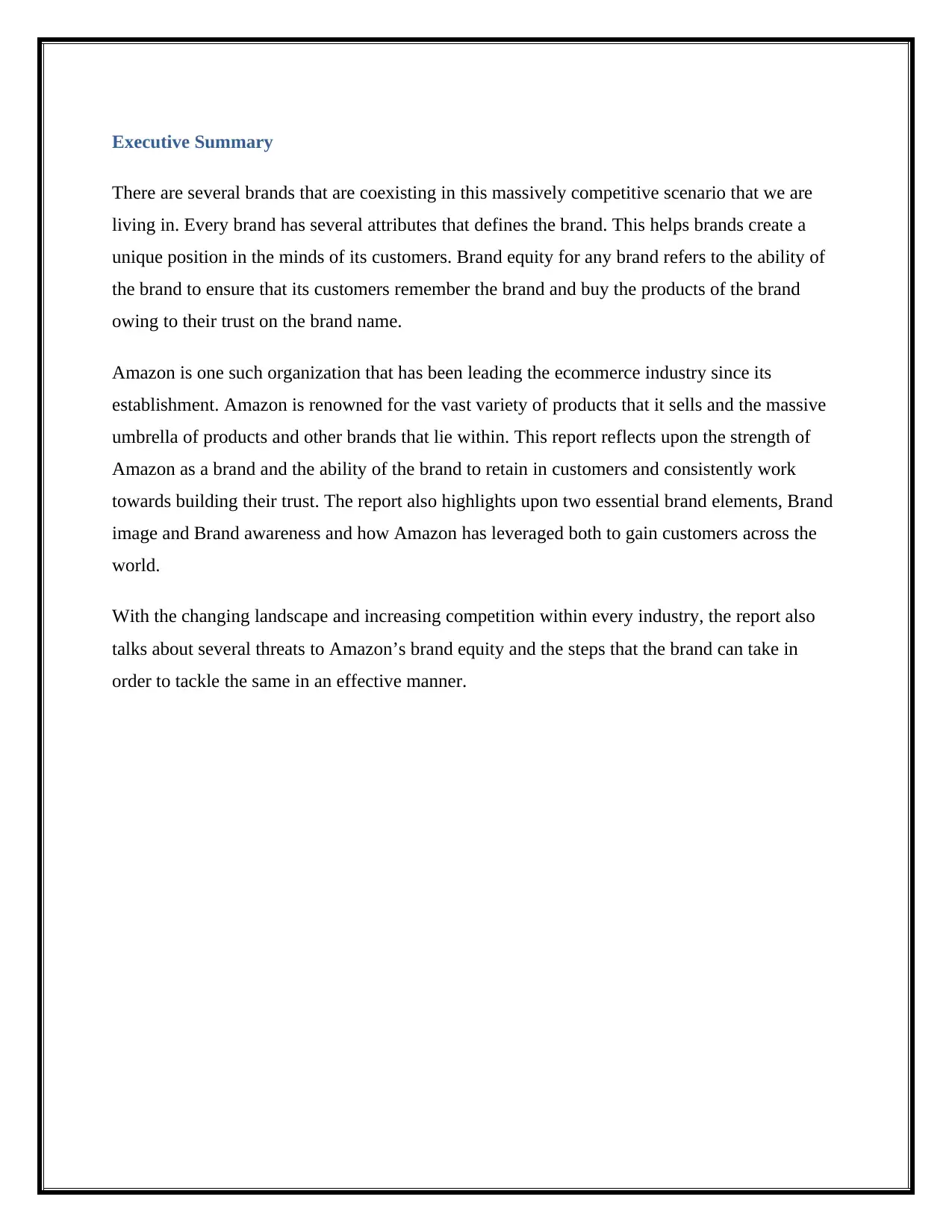
Executive Summary
There are several brands that are coexisting in this massively competitive scenario that we are
living in. Every brand has several attributes that defines the brand. This helps brands create a
unique position in the minds of its customers. Brand equity for any brand refers to the ability of
the brand to ensure that its customers remember the brand and buy the products of the brand
owing to their trust on the brand name.
Amazon is one such organization that has been leading the ecommerce industry since its
establishment. Amazon is renowned for the vast variety of products that it sells and the massive
umbrella of products and other brands that lie within. This report reflects upon the strength of
Amazon as a brand and the ability of the brand to retain in customers and consistently work
towards building their trust. The report also highlights upon two essential brand elements, Brand
image and Brand awareness and how Amazon has leveraged both to gain customers across the
world.
With the changing landscape and increasing competition within every industry, the report also
talks about several threats to Amazon’s brand equity and the steps that the brand can take in
order to tackle the same in an effective manner.
There are several brands that are coexisting in this massively competitive scenario that we are
living in. Every brand has several attributes that defines the brand. This helps brands create a
unique position in the minds of its customers. Brand equity for any brand refers to the ability of
the brand to ensure that its customers remember the brand and buy the products of the brand
owing to their trust on the brand name.
Amazon is one such organization that has been leading the ecommerce industry since its
establishment. Amazon is renowned for the vast variety of products that it sells and the massive
umbrella of products and other brands that lie within. This report reflects upon the strength of
Amazon as a brand and the ability of the brand to retain in customers and consistently work
towards building their trust. The report also highlights upon two essential brand elements, Brand
image and Brand awareness and how Amazon has leveraged both to gain customers across the
world.
With the changing landscape and increasing competition within every industry, the report also
talks about several threats to Amazon’s brand equity and the steps that the brand can take in
order to tackle the same in an effective manner.
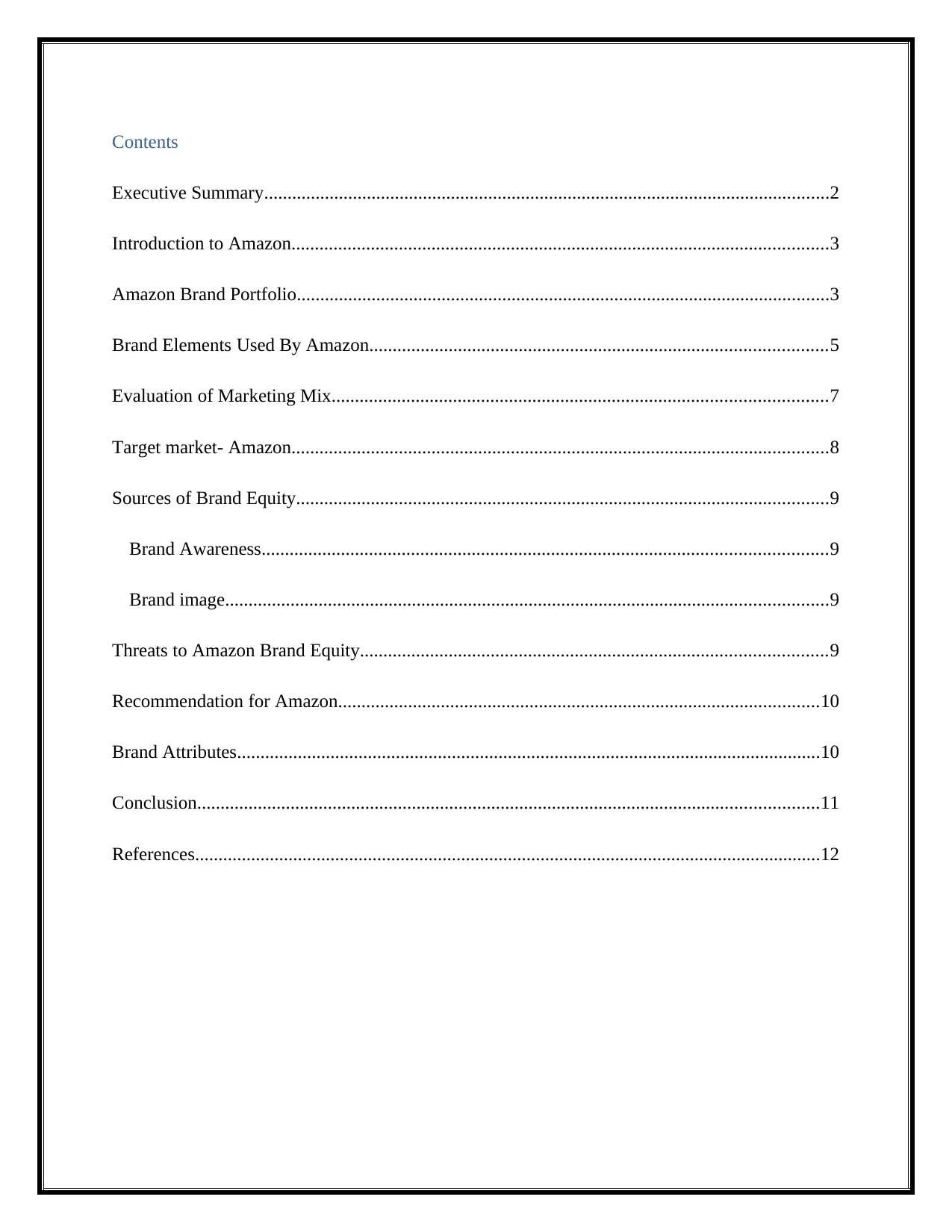
Contents
Executive Summary.........................................................................................................................2
Introduction to Amazon...................................................................................................................3
Amazon Brand Portfolio..................................................................................................................3
Brand Elements Used By Amazon..................................................................................................5
Evaluation of Marketing Mix..........................................................................................................7
Target market- Amazon...................................................................................................................8
Sources of Brand Equity..................................................................................................................9
Brand Awareness.........................................................................................................................9
Brand image.................................................................................................................................9
Threats to Amazon Brand Equity....................................................................................................9
Recommendation for Amazon.......................................................................................................10
Brand Attributes.............................................................................................................................10
Conclusion.....................................................................................................................................11
References......................................................................................................................................12
Executive Summary.........................................................................................................................2
Introduction to Amazon...................................................................................................................3
Amazon Brand Portfolio..................................................................................................................3
Brand Elements Used By Amazon..................................................................................................5
Evaluation of Marketing Mix..........................................................................................................7
Target market- Amazon...................................................................................................................8
Sources of Brand Equity..................................................................................................................9
Brand Awareness.........................................................................................................................9
Brand image.................................................................................................................................9
Threats to Amazon Brand Equity....................................................................................................9
Recommendation for Amazon.......................................................................................................10
Brand Attributes.............................................................................................................................10
Conclusion.....................................................................................................................................11
References......................................................................................................................................12
⊘ This is a preview!⊘
Do you want full access?
Subscribe today to unlock all pages.

Trusted by 1+ million students worldwide

Introduction to Amazon
Amazon.com was incorporated in the year 1996 as an online bookseller, ever since the company
has grown by leaps and bounds to become one of the largest companies in the world. The Seattle
based Technology Company operates through three segments namely: North America,
International & Amazon Web Services. Amazon works on a Marketplace business model, which
implies that the company does not own any product, and just charges a commission from the
sellers registered on its platform. Amazon at present has offices in more than 16 Countries and
ships products across more than One Hundred Countries. The company in the last year entered
the much anticipated and talked about $ 1 Trillion Club, and all this success in just a short span
of time lies strongly on the strong brand values of the company and the vision of its Founder and
CEO Jeff Bezos.
Millions of people across the world shop on Amazon every single day, and the company through
its Amazon Web Services ensures that the data of all its customers is safe and protected with
them. AWS which is a subsidiary of Amazon.com is one of the world’s largest clouds computing
company, which besides keeping all the data and transactions secure for the company, also
provides cloud computing platform to individuals, companies, governments and many more. All
the innovation at Amazon is reflected when it comes to talking about the numbers, the company
showed a jump of 20% from the year 2017 to earn US $ 141.92 Billion in revenues.
Within the purview of the assignment and through the study of Brand portfolio, brand attributes
& brand elements of Amazon we will critique the management of the brand. On the basis of
which certain recommendation will be suggested to improve its brand equity. The assignment
will also apply Branding theory and model to understand Amazon brand in detail and provide
comprehensiveness to the report.
Amazon Brand Portfolio
Brand Portfolio in the simplest of terms refers to an Umbrella under which all other brand or
brand lines of a firm operates in order to serve different needs of the market (Pappu &
Christodoulides, 2017). As mentioned in the Introduction, Amazon.com is one of the biggest e-
commerce companies in the world, which has even challenged the world’s largest retailer
Amazon.com was incorporated in the year 1996 as an online bookseller, ever since the company
has grown by leaps and bounds to become one of the largest companies in the world. The Seattle
based Technology Company operates through three segments namely: North America,
International & Amazon Web Services. Amazon works on a Marketplace business model, which
implies that the company does not own any product, and just charges a commission from the
sellers registered on its platform. Amazon at present has offices in more than 16 Countries and
ships products across more than One Hundred Countries. The company in the last year entered
the much anticipated and talked about $ 1 Trillion Club, and all this success in just a short span
of time lies strongly on the strong brand values of the company and the vision of its Founder and
CEO Jeff Bezos.
Millions of people across the world shop on Amazon every single day, and the company through
its Amazon Web Services ensures that the data of all its customers is safe and protected with
them. AWS which is a subsidiary of Amazon.com is one of the world’s largest clouds computing
company, which besides keeping all the data and transactions secure for the company, also
provides cloud computing platform to individuals, companies, governments and many more. All
the innovation at Amazon is reflected when it comes to talking about the numbers, the company
showed a jump of 20% from the year 2017 to earn US $ 141.92 Billion in revenues.
Within the purview of the assignment and through the study of Brand portfolio, brand attributes
& brand elements of Amazon we will critique the management of the brand. On the basis of
which certain recommendation will be suggested to improve its brand equity. The assignment
will also apply Branding theory and model to understand Amazon brand in detail and provide
comprehensiveness to the report.
Amazon Brand Portfolio
Brand Portfolio in the simplest of terms refers to an Umbrella under which all other brand or
brand lines of a firm operates in order to serve different needs of the market (Pappu &
Christodoulides, 2017). As mentioned in the Introduction, Amazon.com is one of the biggest e-
commerce companies in the world, which has even challenged the world’s largest retailer
Paraphrase This Document
Need a fresh take? Get an instant paraphrase of this document with our AI Paraphraser
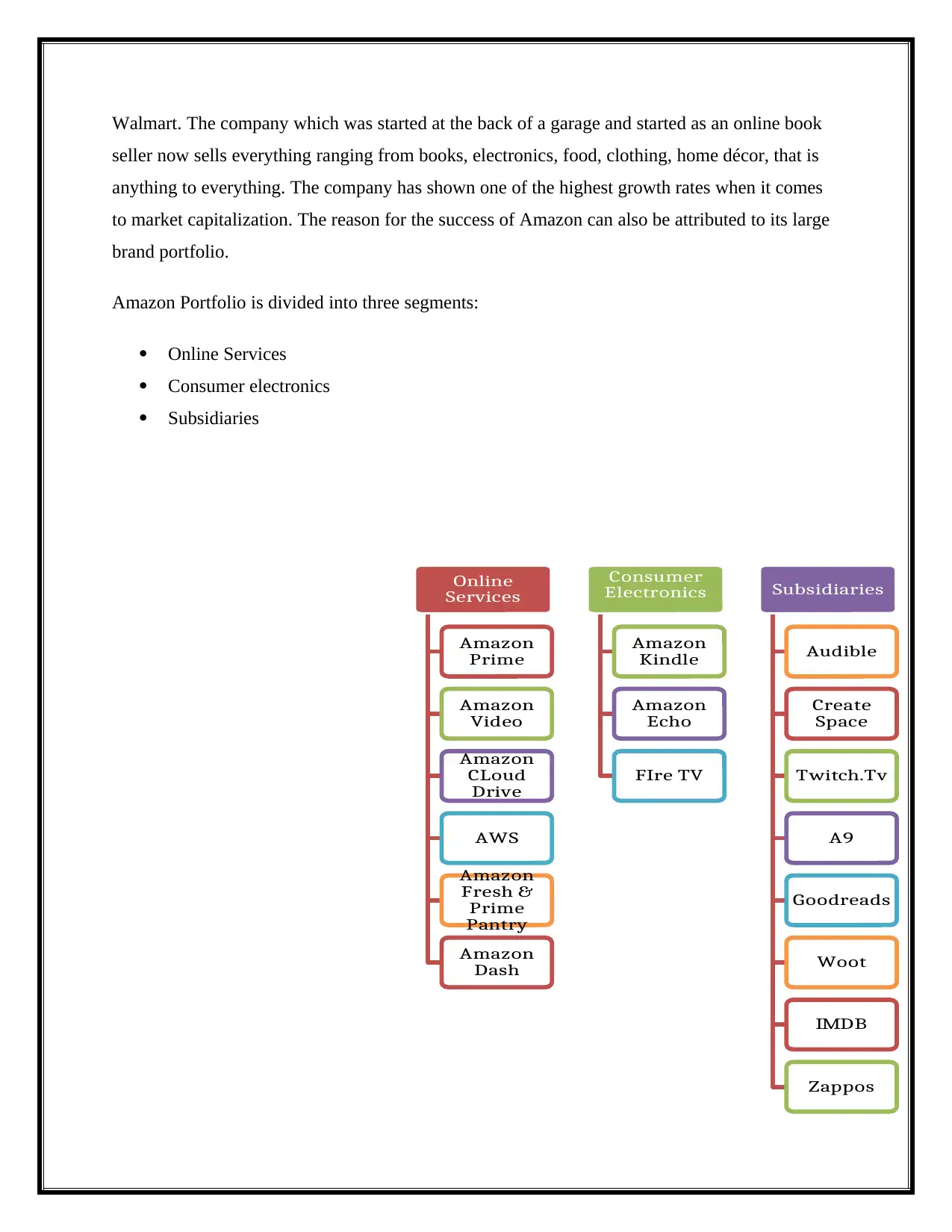
Walmart. The company which was started at the back of a garage and started as an online book
seller now sells everything ranging from books, electronics, food, clothing, home décor, that is
anything to everything. The company has shown one of the highest growth rates when it comes
to market capitalization. The reason for the success of Amazon can also be attributed to its large
brand portfolio.
Amazon Portfolio is divided into three segments:
Online Services
Consumer electronics
Subsidiaries
Online
Services
Amazon
Prime
Amazon
Video
Amazon
CLoud
Drive
AWS
Amazon
Fresh &
Prime
Pantry
Amazon
Dash
Consumer
Electronics
Amazon
Kindle
Amazon
Echo
FIre TV
Subsidiaries
Audible
Create
Space
Twitch.Tv
A9
Goodreads
Woot
IMDB
Zappos
seller now sells everything ranging from books, electronics, food, clothing, home décor, that is
anything to everything. The company has shown one of the highest growth rates when it comes
to market capitalization. The reason for the success of Amazon can also be attributed to its large
brand portfolio.
Amazon Portfolio is divided into three segments:
Online Services
Consumer electronics
Subsidiaries
Online
Services
Amazon
Prime
Amazon
Video
Amazon
CLoud
Drive
AWS
Amazon
Fresh &
Prime
Pantry
Amazon
Dash
Consumer
Electronics
Amazon
Kindle
Amazon
Echo
FIre TV
Subsidiaries
Audible
Create
Space
Twitch.Tv
A9
Goodreads
Woot
IMDB
Zappos
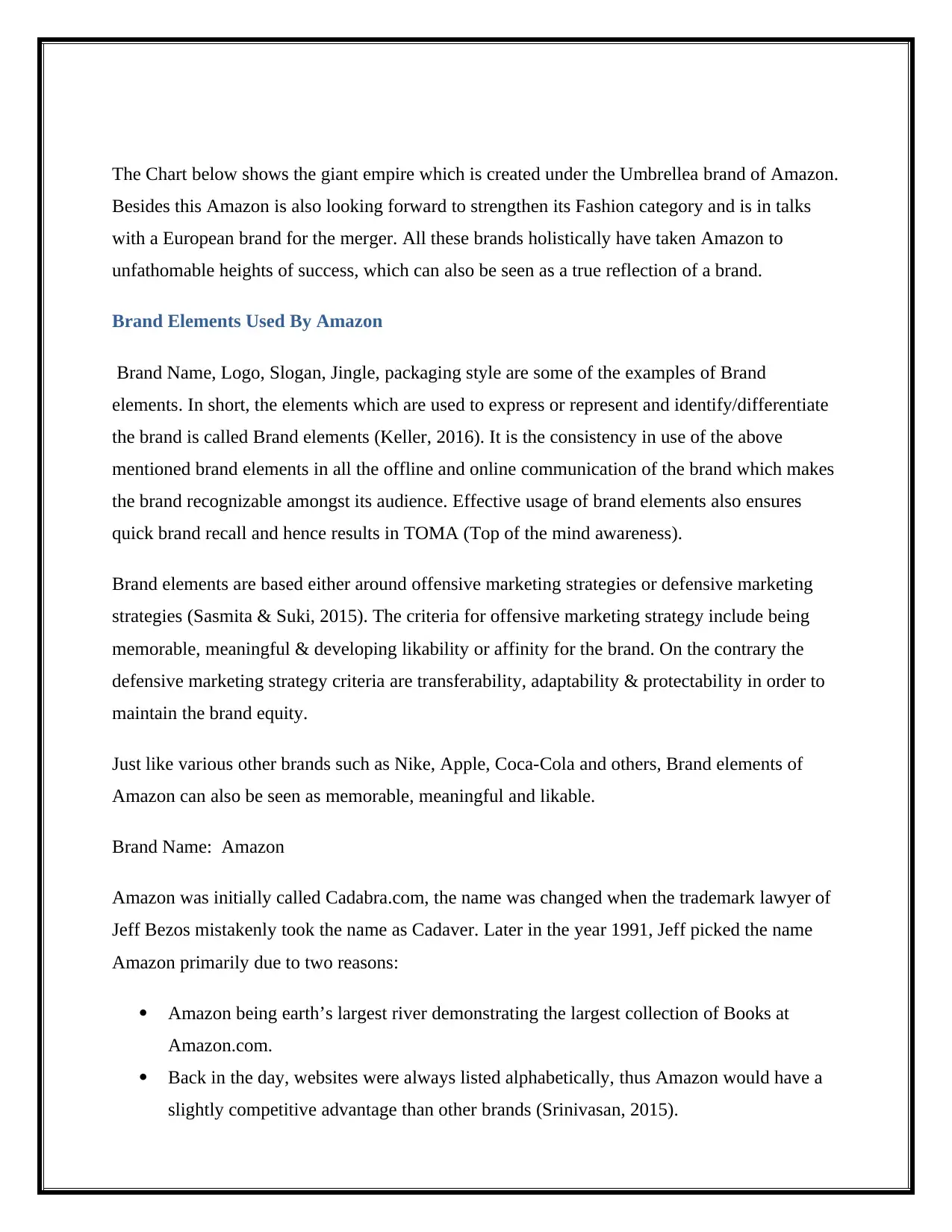
The Chart below shows the giant empire which is created under the Umbrellea brand of Amazon.
Besides this Amazon is also looking forward to strengthen its Fashion category and is in talks
with a European brand for the merger. All these brands holistically have taken Amazon to
unfathomable heights of success, which can also be seen as a true reflection of a brand.
Brand Elements Used By Amazon
Brand Name, Logo, Slogan, Jingle, packaging style are some of the examples of Brand
elements. In short, the elements which are used to express or represent and identify/differentiate
the brand is called Brand elements (Keller, 2016). It is the consistency in use of the above
mentioned brand elements in all the offline and online communication of the brand which makes
the brand recognizable amongst its audience. Effective usage of brand elements also ensures
quick brand recall and hence results in TOMA (Top of the mind awareness).
Brand elements are based either around offensive marketing strategies or defensive marketing
strategies (Sasmita & Suki, 2015). The criteria for offensive marketing strategy include being
memorable, meaningful & developing likability or affinity for the brand. On the contrary the
defensive marketing strategy criteria are transferability, adaptability & protectability in order to
maintain the brand equity.
Just like various other brands such as Nike, Apple, Coca-Cola and others, Brand elements of
Amazon can also be seen as memorable, meaningful and likable.
Brand Name: Amazon
Amazon was initially called Cadabra.com, the name was changed when the trademark lawyer of
Jeff Bezos mistakenly took the name as Cadaver. Later in the year 1991, Jeff picked the name
Amazon primarily due to two reasons:
Amazon being earth’s largest river demonstrating the largest collection of Books at
Amazon.com.
Back in the day, websites were always listed alphabetically, thus Amazon would have a
slightly competitive advantage than other brands (Srinivasan, 2015).
Besides this Amazon is also looking forward to strengthen its Fashion category and is in talks
with a European brand for the merger. All these brands holistically have taken Amazon to
unfathomable heights of success, which can also be seen as a true reflection of a brand.
Brand Elements Used By Amazon
Brand Name, Logo, Slogan, Jingle, packaging style are some of the examples of Brand
elements. In short, the elements which are used to express or represent and identify/differentiate
the brand is called Brand elements (Keller, 2016). It is the consistency in use of the above
mentioned brand elements in all the offline and online communication of the brand which makes
the brand recognizable amongst its audience. Effective usage of brand elements also ensures
quick brand recall and hence results in TOMA (Top of the mind awareness).
Brand elements are based either around offensive marketing strategies or defensive marketing
strategies (Sasmita & Suki, 2015). The criteria for offensive marketing strategy include being
memorable, meaningful & developing likability or affinity for the brand. On the contrary the
defensive marketing strategy criteria are transferability, adaptability & protectability in order to
maintain the brand equity.
Just like various other brands such as Nike, Apple, Coca-Cola and others, Brand elements of
Amazon can also be seen as memorable, meaningful and likable.
Brand Name: Amazon
Amazon was initially called Cadabra.com, the name was changed when the trademark lawyer of
Jeff Bezos mistakenly took the name as Cadaver. Later in the year 1991, Jeff picked the name
Amazon primarily due to two reasons:
Amazon being earth’s largest river demonstrating the largest collection of Books at
Amazon.com.
Back in the day, websites were always listed alphabetically, thus Amazon would have a
slightly competitive advantage than other brands (Srinivasan, 2015).
⊘ This is a preview!⊘
Do you want full access?
Subscribe today to unlock all pages.

Trusted by 1+ million students worldwide
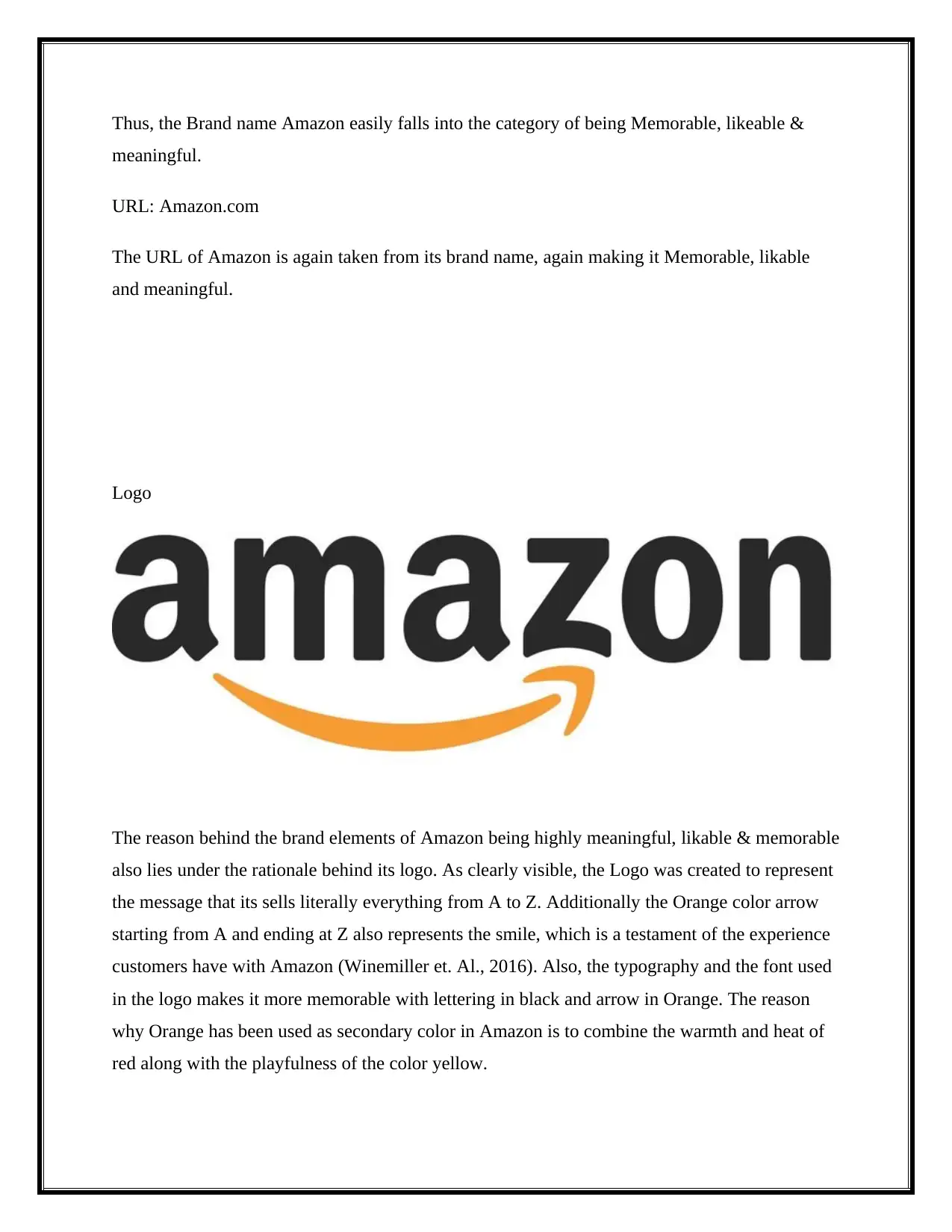
Thus, the Brand name Amazon easily falls into the category of being Memorable, likeable &
meaningful.
URL: Amazon.com
The URL of Amazon is again taken from its brand name, again making it Memorable, likable
and meaningful.
Logo
The reason behind the brand elements of Amazon being highly meaningful, likable & memorable
also lies under the rationale behind its logo. As clearly visible, the Logo was created to represent
the message that its sells literally everything from A to Z. Additionally the Orange color arrow
starting from A and ending at Z also represents the smile, which is a testament of the experience
customers have with Amazon (Winemiller et. Al., 2016). Also, the typography and the font used
in the logo makes it more memorable with lettering in black and arrow in Orange. The reason
why Orange has been used as secondary color in Amazon is to combine the warmth and heat of
red along with the playfulness of the color yellow.
meaningful.
URL: Amazon.com
The URL of Amazon is again taken from its brand name, again making it Memorable, likable
and meaningful.
Logo
The reason behind the brand elements of Amazon being highly meaningful, likable & memorable
also lies under the rationale behind its logo. As clearly visible, the Logo was created to represent
the message that its sells literally everything from A to Z. Additionally the Orange color arrow
starting from A and ending at Z also represents the smile, which is a testament of the experience
customers have with Amazon (Winemiller et. Al., 2016). Also, the typography and the font used
in the logo makes it more memorable with lettering in black and arrow in Orange. The reason
why Orange has been used as secondary color in Amazon is to combine the warmth and heat of
red along with the playfulness of the color yellow.
Paraphrase This Document
Need a fresh take? Get an instant paraphrase of this document with our AI Paraphraser
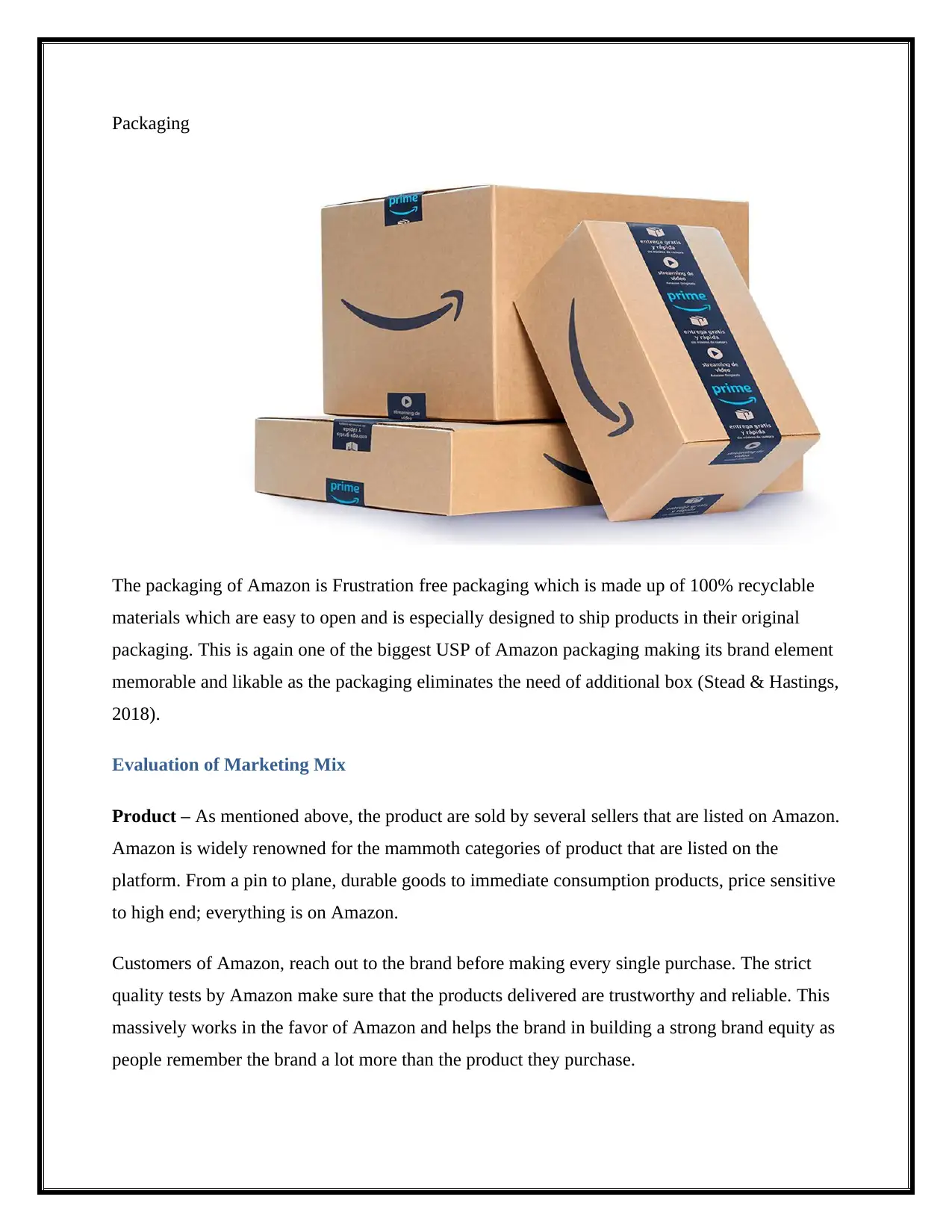
Packaging
The packaging of Amazon is Frustration free packaging which is made up of 100% recyclable
materials which are easy to open and is especially designed to ship products in their original
packaging. This is again one of the biggest USP of Amazon packaging making its brand element
memorable and likable as the packaging eliminates the need of additional box (Stead & Hastings,
2018).
Evaluation of Marketing Mix
Product – As mentioned above, the product are sold by several sellers that are listed on Amazon.
Amazon is widely renowned for the mammoth categories of product that are listed on the
platform. From a pin to plane, durable goods to immediate consumption products, price sensitive
to high end; everything is on Amazon.
Customers of Amazon, reach out to the brand before making every single purchase. The strict
quality tests by Amazon make sure that the products delivered are trustworthy and reliable. This
massively works in the favor of Amazon and helps the brand in building a strong brand equity as
people remember the brand a lot more than the product they purchase.
The packaging of Amazon is Frustration free packaging which is made up of 100% recyclable
materials which are easy to open and is especially designed to ship products in their original
packaging. This is again one of the biggest USP of Amazon packaging making its brand element
memorable and likable as the packaging eliminates the need of additional box (Stead & Hastings,
2018).
Evaluation of Marketing Mix
Product – As mentioned above, the product are sold by several sellers that are listed on Amazon.
Amazon is widely renowned for the mammoth categories of product that are listed on the
platform. From a pin to plane, durable goods to immediate consumption products, price sensitive
to high end; everything is on Amazon.
Customers of Amazon, reach out to the brand before making every single purchase. The strict
quality tests by Amazon make sure that the products delivered are trustworthy and reliable. This
massively works in the favor of Amazon and helps the brand in building a strong brand equity as
people remember the brand a lot more than the product they purchase.
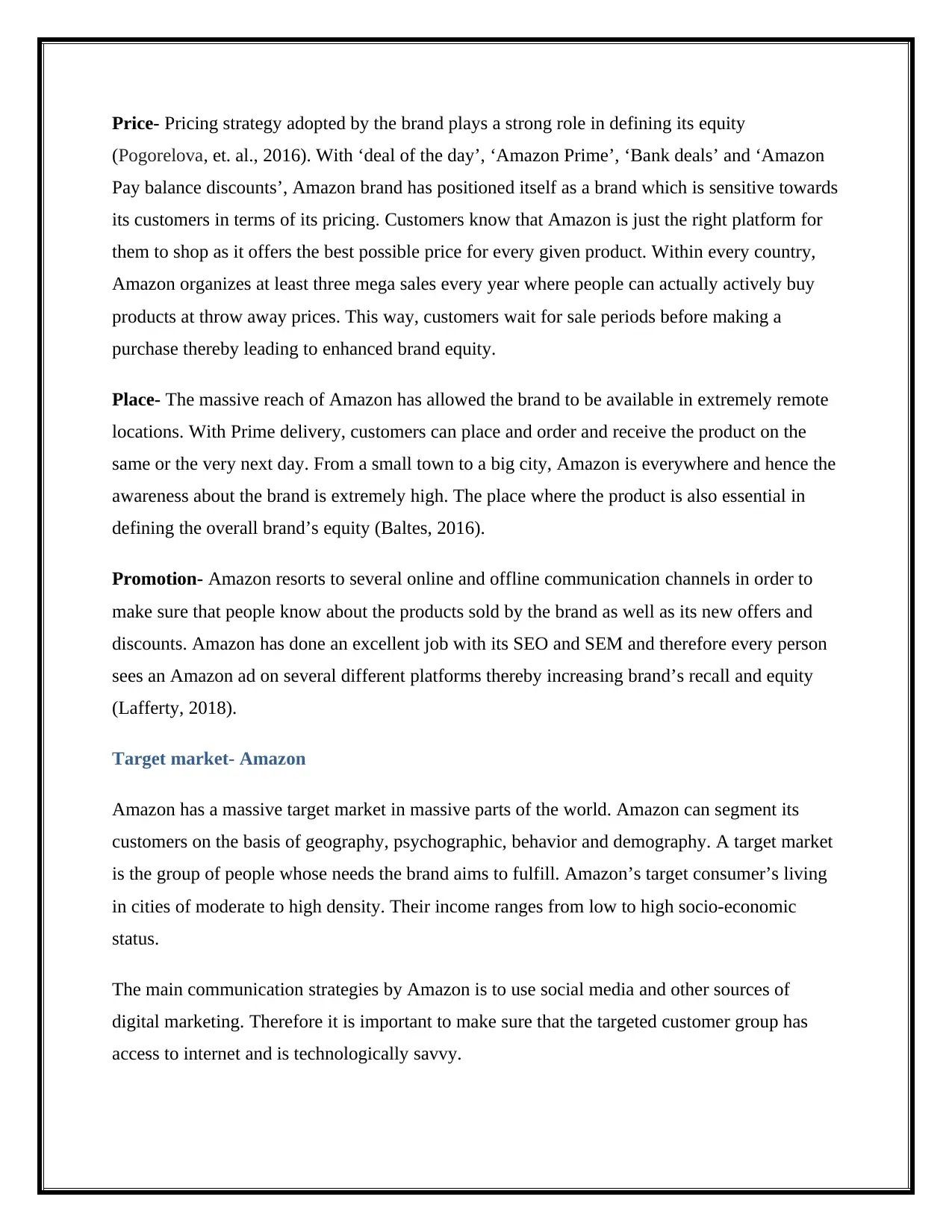
Price- Pricing strategy adopted by the brand plays a strong role in defining its equity
(Pogorelova, et. al., 2016). With ‘deal of the day’, ‘Amazon Prime’, ‘Bank deals’ and ‘Amazon
Pay balance discounts’, Amazon brand has positioned itself as a brand which is sensitive towards
its customers in terms of its pricing. Customers know that Amazon is just the right platform for
them to shop as it offers the best possible price for every given product. Within every country,
Amazon organizes at least three mega sales every year where people can actually actively buy
products at throw away prices. This way, customers wait for sale periods before making a
purchase thereby leading to enhanced brand equity.
Place- The massive reach of Amazon has allowed the brand to be available in extremely remote
locations. With Prime delivery, customers can place and order and receive the product on the
same or the very next day. From a small town to a big city, Amazon is everywhere and hence the
awareness about the brand is extremely high. The place where the product is also essential in
defining the overall brand’s equity (Baltes, 2016).
Promotion- Amazon resorts to several online and offline communication channels in order to
make sure that people know about the products sold by the brand as well as its new offers and
discounts. Amazon has done an excellent job with its SEO and SEM and therefore every person
sees an Amazon ad on several different platforms thereby increasing brand’s recall and equity
(Lafferty, 2018).
Target market- Amazon
Amazon has a massive target market in massive parts of the world. Amazon can segment its
customers on the basis of geography, psychographic, behavior and demography. A target market
is the group of people whose needs the brand aims to fulfill. Amazon’s target consumer’s living
in cities of moderate to high density. Their income ranges from low to high socio-economic
status.
The main communication strategies by Amazon is to use social media and other sources of
digital marketing. Therefore it is important to make sure that the targeted customer group has
access to internet and is technologically savvy.
(Pogorelova, et. al., 2016). With ‘deal of the day’, ‘Amazon Prime’, ‘Bank deals’ and ‘Amazon
Pay balance discounts’, Amazon brand has positioned itself as a brand which is sensitive towards
its customers in terms of its pricing. Customers know that Amazon is just the right platform for
them to shop as it offers the best possible price for every given product. Within every country,
Amazon organizes at least three mega sales every year where people can actually actively buy
products at throw away prices. This way, customers wait for sale periods before making a
purchase thereby leading to enhanced brand equity.
Place- The massive reach of Amazon has allowed the brand to be available in extremely remote
locations. With Prime delivery, customers can place and order and receive the product on the
same or the very next day. From a small town to a big city, Amazon is everywhere and hence the
awareness about the brand is extremely high. The place where the product is also essential in
defining the overall brand’s equity (Baltes, 2016).
Promotion- Amazon resorts to several online and offline communication channels in order to
make sure that people know about the products sold by the brand as well as its new offers and
discounts. Amazon has done an excellent job with its SEO and SEM and therefore every person
sees an Amazon ad on several different platforms thereby increasing brand’s recall and equity
(Lafferty, 2018).
Target market- Amazon
Amazon has a massive target market in massive parts of the world. Amazon can segment its
customers on the basis of geography, psychographic, behavior and demography. A target market
is the group of people whose needs the brand aims to fulfill. Amazon’s target consumer’s living
in cities of moderate to high density. Their income ranges from low to high socio-economic
status.
The main communication strategies by Amazon is to use social media and other sources of
digital marketing. Therefore it is important to make sure that the targeted customer group has
access to internet and is technologically savvy.
⊘ This is a preview!⊘
Do you want full access?
Subscribe today to unlock all pages.

Trusted by 1+ million students worldwide
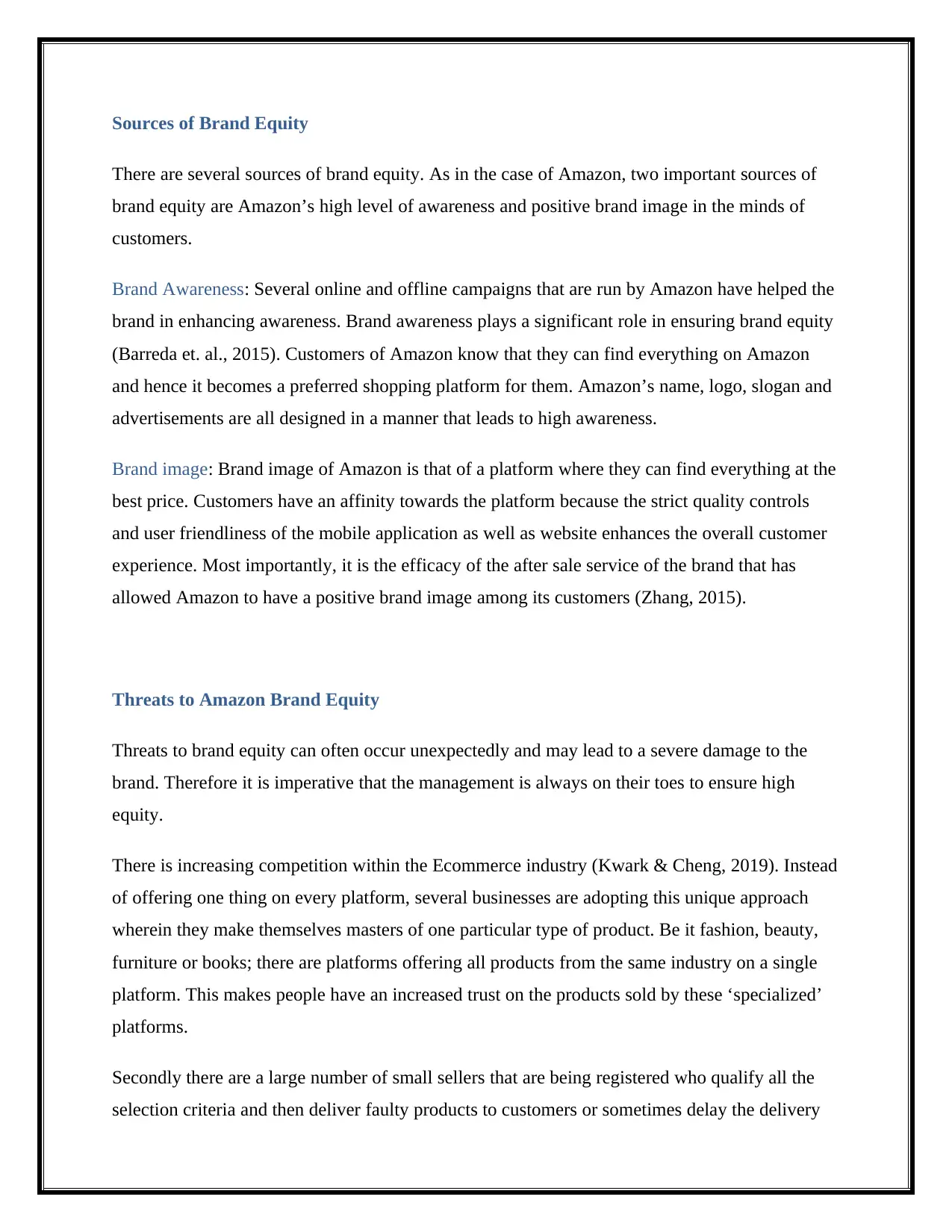
Sources of Brand Equity
There are several sources of brand equity. As in the case of Amazon, two important sources of
brand equity are Amazon’s high level of awareness and positive brand image in the minds of
customers.
Brand Awareness: Several online and offline campaigns that are run by Amazon have helped the
brand in enhancing awareness. Brand awareness plays a significant role in ensuring brand equity
(Barreda et. al., 2015). Customers of Amazon know that they can find everything on Amazon
and hence it becomes a preferred shopping platform for them. Amazon’s name, logo, slogan and
advertisements are all designed in a manner that leads to high awareness.
Brand image: Brand image of Amazon is that of a platform where they can find everything at the
best price. Customers have an affinity towards the platform because the strict quality controls
and user friendliness of the mobile application as well as website enhances the overall customer
experience. Most importantly, it is the efficacy of the after sale service of the brand that has
allowed Amazon to have a positive brand image among its customers (Zhang, 2015).
Threats to Amazon Brand Equity
Threats to brand equity can often occur unexpectedly and may lead to a severe damage to the
brand. Therefore it is imperative that the management is always on their toes to ensure high
equity.
There is increasing competition within the Ecommerce industry (Kwark & Cheng, 2019). Instead
of offering one thing on every platform, several businesses are adopting this unique approach
wherein they make themselves masters of one particular type of product. Be it fashion, beauty,
furniture or books; there are platforms offering all products from the same industry on a single
platform. This makes people have an increased trust on the products sold by these ‘specialized’
platforms.
Secondly there are a large number of small sellers that are being registered who qualify all the
selection criteria and then deliver faulty products to customers or sometimes delay the delivery
There are several sources of brand equity. As in the case of Amazon, two important sources of
brand equity are Amazon’s high level of awareness and positive brand image in the minds of
customers.
Brand Awareness: Several online and offline campaigns that are run by Amazon have helped the
brand in enhancing awareness. Brand awareness plays a significant role in ensuring brand equity
(Barreda et. al., 2015). Customers of Amazon know that they can find everything on Amazon
and hence it becomes a preferred shopping platform for them. Amazon’s name, logo, slogan and
advertisements are all designed in a manner that leads to high awareness.
Brand image: Brand image of Amazon is that of a platform where they can find everything at the
best price. Customers have an affinity towards the platform because the strict quality controls
and user friendliness of the mobile application as well as website enhances the overall customer
experience. Most importantly, it is the efficacy of the after sale service of the brand that has
allowed Amazon to have a positive brand image among its customers (Zhang, 2015).
Threats to Amazon Brand Equity
Threats to brand equity can often occur unexpectedly and may lead to a severe damage to the
brand. Therefore it is imperative that the management is always on their toes to ensure high
equity.
There is increasing competition within the Ecommerce industry (Kwark & Cheng, 2019). Instead
of offering one thing on every platform, several businesses are adopting this unique approach
wherein they make themselves masters of one particular type of product. Be it fashion, beauty,
furniture or books; there are platforms offering all products from the same industry on a single
platform. This makes people have an increased trust on the products sold by these ‘specialized’
platforms.
Secondly there are a large number of small sellers that are being registered who qualify all the
selection criteria and then deliver faulty products to customers or sometimes delay the delivery
Paraphrase This Document
Need a fresh take? Get an instant paraphrase of this document with our AI Paraphraser
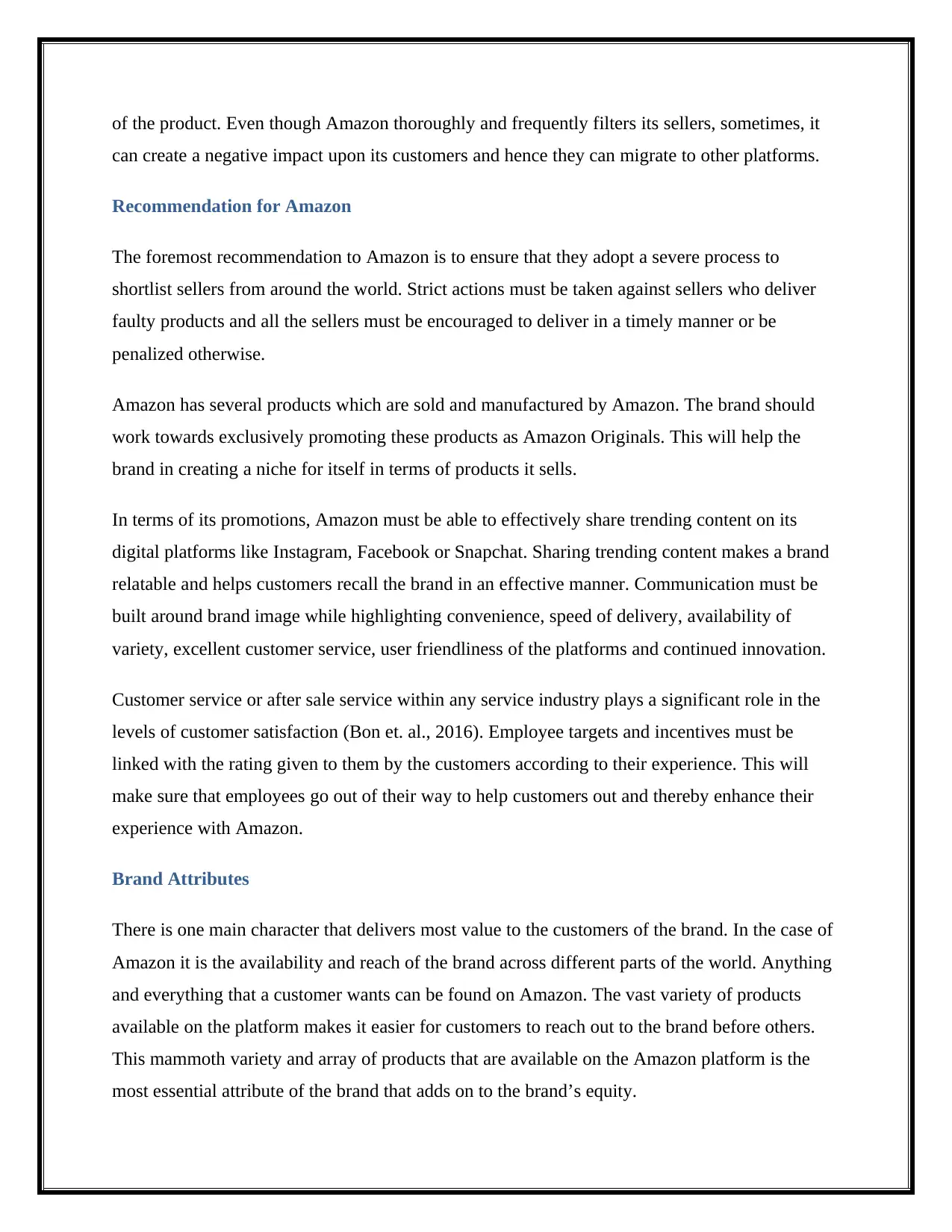
of the product. Even though Amazon thoroughly and frequently filters its sellers, sometimes, it
can create a negative impact upon its customers and hence they can migrate to other platforms.
Recommendation for Amazon
The foremost recommendation to Amazon is to ensure that they adopt a severe process to
shortlist sellers from around the world. Strict actions must be taken against sellers who deliver
faulty products and all the sellers must be encouraged to deliver in a timely manner or be
penalized otherwise.
Amazon has several products which are sold and manufactured by Amazon. The brand should
work towards exclusively promoting these products as Amazon Originals. This will help the
brand in creating a niche for itself in terms of products it sells.
In terms of its promotions, Amazon must be able to effectively share trending content on its
digital platforms like Instagram, Facebook or Snapchat. Sharing trending content makes a brand
relatable and helps customers recall the brand in an effective manner. Communication must be
built around brand image while highlighting convenience, speed of delivery, availability of
variety, excellent customer service, user friendliness of the platforms and continued innovation.
Customer service or after sale service within any service industry plays a significant role in the
levels of customer satisfaction (Bon et. al., 2016). Employee targets and incentives must be
linked with the rating given to them by the customers according to their experience. This will
make sure that employees go out of their way to help customers out and thereby enhance their
experience with Amazon.
Brand Attributes
There is one main character that delivers most value to the customers of the brand. In the case of
Amazon it is the availability and reach of the brand across different parts of the world. Anything
and everything that a customer wants can be found on Amazon. The vast variety of products
available on the platform makes it easier for customers to reach out to the brand before others.
This mammoth variety and array of products that are available on the Amazon platform is the
most essential attribute of the brand that adds on to the brand’s equity.
can create a negative impact upon its customers and hence they can migrate to other platforms.
Recommendation for Amazon
The foremost recommendation to Amazon is to ensure that they adopt a severe process to
shortlist sellers from around the world. Strict actions must be taken against sellers who deliver
faulty products and all the sellers must be encouraged to deliver in a timely manner or be
penalized otherwise.
Amazon has several products which are sold and manufactured by Amazon. The brand should
work towards exclusively promoting these products as Amazon Originals. This will help the
brand in creating a niche for itself in terms of products it sells.
In terms of its promotions, Amazon must be able to effectively share trending content on its
digital platforms like Instagram, Facebook or Snapchat. Sharing trending content makes a brand
relatable and helps customers recall the brand in an effective manner. Communication must be
built around brand image while highlighting convenience, speed of delivery, availability of
variety, excellent customer service, user friendliness of the platforms and continued innovation.
Customer service or after sale service within any service industry plays a significant role in the
levels of customer satisfaction (Bon et. al., 2016). Employee targets and incentives must be
linked with the rating given to them by the customers according to their experience. This will
make sure that employees go out of their way to help customers out and thereby enhance their
experience with Amazon.
Brand Attributes
There is one main character that delivers most value to the customers of the brand. In the case of
Amazon it is the availability and reach of the brand across different parts of the world. Anything
and everything that a customer wants can be found on Amazon. The vast variety of products
available on the platform makes it easier for customers to reach out to the brand before others.
This mammoth variety and array of products that are available on the Amazon platform is the
most essential attribute of the brand that adds on to the brand’s equity.
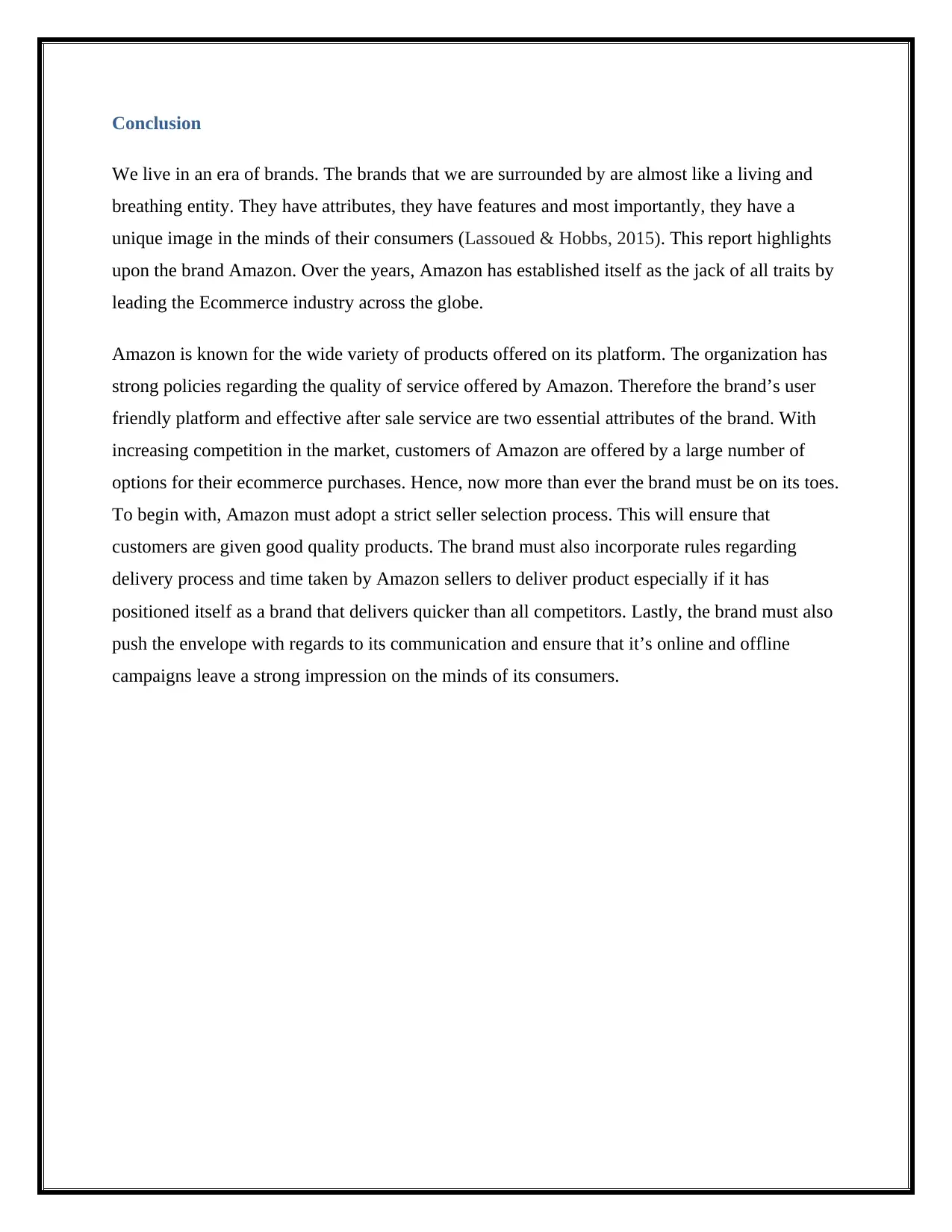
Conclusion
We live in an era of brands. The brands that we are surrounded by are almost like a living and
breathing entity. They have attributes, they have features and most importantly, they have a
unique image in the minds of their consumers (Lassoued & Hobbs, 2015). This report highlights
upon the brand Amazon. Over the years, Amazon has established itself as the jack of all traits by
leading the Ecommerce industry across the globe.
Amazon is known for the wide variety of products offered on its platform. The organization has
strong policies regarding the quality of service offered by Amazon. Therefore the brand’s user
friendly platform and effective after sale service are two essential attributes of the brand. With
increasing competition in the market, customers of Amazon are offered by a large number of
options for their ecommerce purchases. Hence, now more than ever the brand must be on its toes.
To begin with, Amazon must adopt a strict seller selection process. This will ensure that
customers are given good quality products. The brand must also incorporate rules regarding
delivery process and time taken by Amazon sellers to deliver product especially if it has
positioned itself as a brand that delivers quicker than all competitors. Lastly, the brand must also
push the envelope with regards to its communication and ensure that it’s online and offline
campaigns leave a strong impression on the minds of its consumers.
We live in an era of brands. The brands that we are surrounded by are almost like a living and
breathing entity. They have attributes, they have features and most importantly, they have a
unique image in the minds of their consumers (Lassoued & Hobbs, 2015). This report highlights
upon the brand Amazon. Over the years, Amazon has established itself as the jack of all traits by
leading the Ecommerce industry across the globe.
Amazon is known for the wide variety of products offered on its platform. The organization has
strong policies regarding the quality of service offered by Amazon. Therefore the brand’s user
friendly platform and effective after sale service are two essential attributes of the brand. With
increasing competition in the market, customers of Amazon are offered by a large number of
options for their ecommerce purchases. Hence, now more than ever the brand must be on its toes.
To begin with, Amazon must adopt a strict seller selection process. This will ensure that
customers are given good quality products. The brand must also incorporate rules regarding
delivery process and time taken by Amazon sellers to deliver product especially if it has
positioned itself as a brand that delivers quicker than all competitors. Lastly, the brand must also
push the envelope with regards to its communication and ensure that it’s online and offline
campaigns leave a strong impression on the minds of its consumers.
⊘ This is a preview!⊘
Do you want full access?
Subscribe today to unlock all pages.

Trusted by 1+ million students worldwide
1 out of 14
Related Documents
Your All-in-One AI-Powered Toolkit for Academic Success.
+13062052269
info@desklib.com
Available 24*7 on WhatsApp / Email
![[object Object]](/_next/static/media/star-bottom.7253800d.svg)
Unlock your academic potential
Copyright © 2020–2025 A2Z Services. All Rights Reserved. Developed and managed by ZUCOL.





